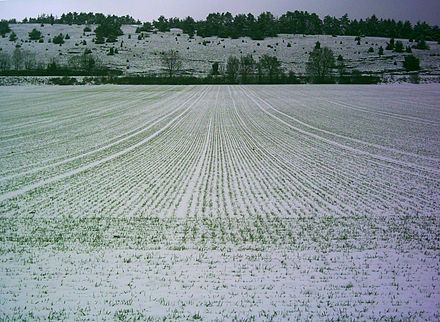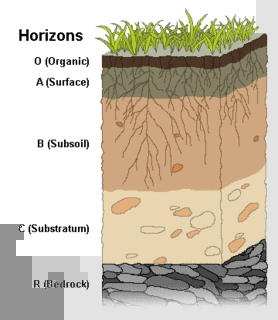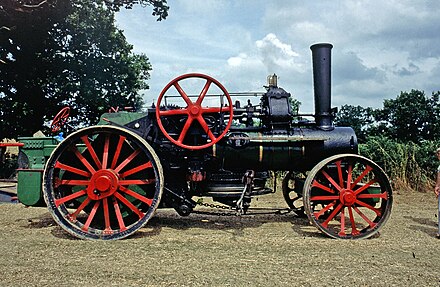
Tillage is the agricultural preparation of soil by mechanical agitation of various types, such as digging, stirring, and overturning. Examples of human-powered tilling methods using hand tools include shovelling, picking, mattock work, hoeing, and raking. Examples of draft-animal-powered or mechanized work include ploughing, rototilling, rolling with cultipackers or other rollers, harrowing, and cultivating with cultivator shanks (teeth). Small-scale gardening and farming, for household food production or small business production, tends to use the smaller-scale methods, whereas medium- to large-scale farming tends to use the larger-scale methods.
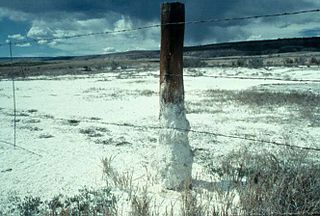
Soil salinity is the salt content in the soil; the process of increasing the salt content is known as salinization. Salts occur naturally within soils and water. Salination can be caused by natural processes such as mineral weathering or by the gradual withdrawal of an ocean. It can also come about through artificial processes such as irrigation and road salt.

A tractor is an engineering vehicle specifically designed to deliver a high tractive effort at slow speeds, for the purposes of hauling a trailer or machinery used in agriculture or construction. Most commonly, the term is used to describe a farm vehicle that provides the power and traction to mechanize agricultural tasks, especially tillage, but nowadays a great variety of tasks. Agricultural implements may be towed behind or mounted on the tractor, and the tractor may also provide a source of power if the implement is mechanised.

In agriculture, a harrow is an implement for breaking up and smoothing out the surface of the soil. In this way it is distinct in its effect from the plough, which is used for deeper tillage. Harrowing is often carried out on fields to follow the rough finish left by plowing operations. The purpose of this harrowing is generally to break up clods and to provide a finer finish, a good tilth or soil structure that is suitable for seedbed use. Coarser harrowing may also be used to remove weeds and to cover seed after sowing. Harrows differ from cultivators in that they disturb the whole surface of the soil, such as to prepare a seedbed, instead of disturbing only narrow trails that skirt crop rows.

The British Agricultural Revolution, or Second Agricultural Revolution, was the unprecedented increase in agricultural production in Britain due to increases in labour and land productivity between the mid-17th and late 19th centuries. Agricultural output grew faster than the population over the century to 1770, and thereafter productivity remained among the highest in the world. This increase in the food supply contributed to the rapid growth of population in England and Wales, from 5.5 million in 1700 to over 9 million by 1801, though domestic production gave way increasingly to food imports in the nineteenth century as the population more than tripled to over 32 million. The rise in productivity accelerated the decline of the agricultural share of the labour force, adding to the urban workforce on which industrialization depended: the Agricultural Revolution has therefore been cited as a cause of the Industrial Revolution.
Conservation agriculture (CA) can be defined by a statement given by the Food and Agriculture Organization of the United Nations as “a concept for resource-saving agricultural crop production that strives to achieve acceptable profits together with high and sustained production levels while concurrently conserving the environment”.

A traction engine is a self-propelled steam engine used to move heavy loads on roads, plough ground or to provide power at a chosen location. The name derives from the Latin tractus, meaning 'drawn', since the prime function of any traction engine is to draw a load behind it. They are sometimes called road locomotives to distinguish them from railway locomotives – that is, steam engines that run on rails.

Dryland farming and dry farming encompass specific agricultural techniques for the non-irrigated cultivation of crops. Dryland farming is associated with drylands, areas characterized by a cool wet season that is followed by a warm dry season. They are also associated with arid conditions or areas prone to drought or having scarce water resources. Additionally, arid-zone agriculture is being developed for this purpose.

Ridge and furrow is an archaeological pattern of ridges and troughs created by a system of ploughing used in Europe during the Middle Ages, typical of the open field system. It is also known as rigand furrow, mostly in the North East of England and in Scotland.

Soil conservation is the prevention of soil loss from erosion or prevention of reduced fertility caused by over usage, acidification, salinization or other chemical soil contamination.

A cultivator is any of several types of farm implement used for secondary tillage. One sense of the name refers to frames with teeth that pierce the soil as they are dragged through it linearly. Another sense refers to machines that use rotary motion of disks or teeth to accomplish a similar result. The rotary tiller is a principal example.
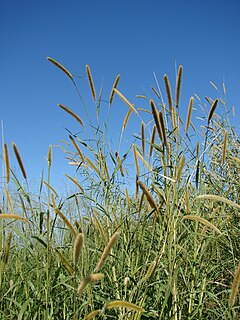
Pennisetum purpureum, also known as Napier grass, elephant grass or Uganda grass, is a species of perennial tropical grass native to the African grasslands. It has low water and nutrient requirements, and therefore can make use of otherwise uncultivated lands. Historically, this wild species has been used primarily for grazing; recently, however, it has been used as part of a push–pull agricultural pest management strategy. This technique involves the desired crop being planted alongside a 'push' plant, which repels pests, in combination with a 'pull' crop around the perimeter of the plot, which draw insects out of the plot. Napier grass has shown potential at attracting stemborer moths away from maize and hence is the "pull" crop. This strategy is much more sustainable, serves more purposes and is more affordable for farmers than insecticide use. In addition to this, Napier grasses improve soil fertility, and protect arid land from soil erosion. It is also utilized for firebreaks, windbreaks, in paper pulp production and most recently to produce bio-oil, biogas and charcoal.

A subsoiler or flat lifter is a tractor-mounted farm implement used for deep tillage, loosening and breaking up soil at depths below the levels worked by moldboard ploughs, disc harrows, or rototillers. Most such tools will break up and turn over surface soil to a depth of 15–20 cm (5.9–7.9 in), whereas a subsoiler will break up and loosen soil to twice those depths. Typically a subsoiler mounted on a compact utility tractor will reach depths of about 30 cm (12 in) and typically have only one thin blade with a sharpened tip.

Pratylenchus penetrans is a species of nematode in the genus Pratylenchus, the lesion nematodes. It occurs in temperate regions worldwide, regions between the subtropics and the polar circles. It is an animal that inhabits the roots of a wide variety of plants and results in necrotic lesions on the roots. Symptoms of P. penetrans make it hard to distinguish from other plant pathogens; only an assay of soil can conclusively diagnose a nematode problem in the field. P. penetrans is physically very similar to other nematode species, but is characterized by its highly distinctive mouthpiece. P. penetrans uses its highly modified mouth organs to rupture the outer surface of subterranean plant root structures. It will then enter into the root interior and feed on the plant tissue inside. P. penetrans is considered to be a crop parasite and farmers will often treat their soil with various pesticides in an attempt to eliminate the damage caused by an infestation. In doing this, farmers will also eliminate many of the beneficial soil fauna, which will lead to an overall degradation of soil quality in the future. Alternative, more environmentally sustainable methods to control P. penetrans populations may be possible in certain regions.
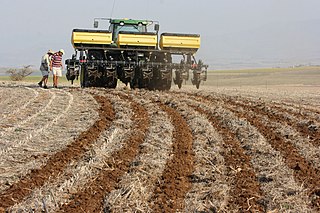
Strip-till is a conservation system that uses a minimum tillage. It combines the soil drying and warming benefits of conventional tillage with the soil-protecting advantages of no-till by disturbing only the portion of the soil that is to contain the seed row. This type of tillage is performed with special equipment and can require the farmer to make multiple trips, depending on the strip-till implement used, and field conditions. Each row that has been strip-tilled is usually about eight to ten inches wide.
In regard to agriculture, Abiotic stress is stress produced by natural environment factors such as extreme temperatures, wind, drought, and salinity. Humankind doesn’t have much control over abiotic stresses. It is very important for humans to understand how stress factors affect plants and other living things so that we can take some preventative measures.
Controlled traffic farming (CTF) is a management tool which is used to reduce the damage to soils caused by heavy or repeated agricultural machinery passes on the land. This damage and its negative consequences have been well documented and include increased fuel use, poor seedbeds, reduced crop yields and poor soil function in terms of water infiltration, drainage and greenhouse gas mitigation due to soil compaction.
Chrysopogon nigritanus, more widely known by the taxonomic synonym Vetiveria nigritana, or the common name black vetivergrass, is a perennial grass species of the Poaceae family and therefore is also a monocotyledon. More specifically, Vetiveria nigritana is a very thick and tall type of grass that is deeply rooted within the ground and is usually used to protect crops and deter soil erosion. Vetiveria nigritana is also a native species to Africa and is most commonly seen in Nigeria, Northern Africa, Eastern Africa and tropical parts of Southern Africa. In addition, the plant, like other vetiver grasses, has been used in these regions due to its extreme drought tolerance, ability to grow in infertile soil and the fact that it can live under complete submergence. In fact, Vetiveria nigritana can thrive in a very diverse range of environmental and climatic conditions.
Soil compaction, also known as soil structure degradation, is the increase of bulk density or decrease in porosity of soil due to externally or internally applied loads. Compaction can adversely affect nearly all physical, chemical and biological properties and functions of soil. Together with soil erosion, it is regarded as the "costliest and most serious environmental problem caused by conventional agriculture."
